Safety in the Laboratory

Safety in the Laboratory |
 |
TransportMove gas cylinders only in an adequate cart Only move gas cylinders w/o their regulator and their valve taped by the safety cap Due to the weight of a gas cylinder exist a risk of bruise for hands and feed during transport |
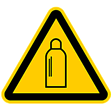 |
StorageAlways secure gas cylinders against tumble over (e.g. with a chain) Do not leave gas cylinders in ways or emergency exits Installation of gas cylinders outside of the laboratory are preferable Store gas cylinders in fresh and good ventilated places Gas cylinders not in use should have the regulator removed and the valve taped by the safety cap Caution: If the valve breaks the gas will expand and accelerate the cylinder like a rocket! Additionally, the oxygen from the air will be displaced by the released gas: asphyxia Empty gas bottles should be marked |
 |
UsageInstallation: Proof the etiquett and colour code to assure using the correct gas Check that the regulator sealing surface and the connector threads are clean and undamaged Tighten the regulator to the cylinder using a wrench Do not orientate the regulator in direction to other gas cylinders Check that the connections of the gas line going to the regulator are not damaged and attach the gas line. Using (non toxic gases!): Close the regulator by turning handle (2) counter clockwise Open the valve on the cylinder (1) slowly by turning it counter clockwise → inlet pressure gauge (a) shows pressure of the cylinder (about 50 bar = 725 psi) when pressure drops to 400 psi the cylinder is close to be empty Set the desired operating pressure by turning the regulator handle (2) clockwise → outlet pressure gauge (b) shows pressure leaving the system (e.g. 0.3 bar = 4.3 psi) never exceed 4.3 psi as higher pressures will damages the valves of the incubator Open the final valve (3) for accessing to the gas Remove (or finishing): Close the valve on the cylinder (1) by turning it clockwise When inlet pressure gauge (a) is at its minimum, close the regulator handle (2) by turning (counter clockwise) Close the final valve (3) → Removing only: Remove the regulator from the gas bottle by turning the nut on the regulator adapter counter clockwise. Screw the safety cap onto the cylinder and mark it as empty |
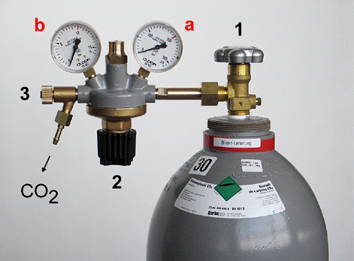
|
SignsColours for gas cylinders are in Europe standardized according to EN 1089-3: gas mixtures and pure gases. In the USA and in many other countries (like Mexico) the colour coding of gas cylinders is not regulated by law. Do not rely on the colours of a gas cylinder for identifying its content! |
red: flammable yellow: toxic or corrosive blue: oxidizing green: inert |
| A cryogenic gas cylinder broke at its bottom and thus jetted upwards breaking a whole into a concrete floor. The gas discharge also blew out the walls of the lab where the tank was stored. |
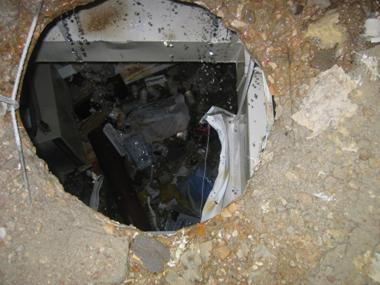 |
| The Problem: | |
| - A Bunsen burner was connected to the gas outlet of the BSC with an inadequate tube - además el flujo de gas era interrumpido solo con el mechero y no con la válvula principal => gas flew out of the rotten tubing and accumulated to an explosive mixture within the BSC (front screen was closed) |
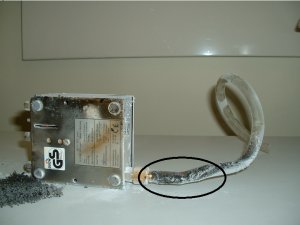 |
| Consequence: | |
| → by turning on the BSC the gas mixture exploded → the studend suffered burns of first and second grade → the wall next to the BSC broke down |
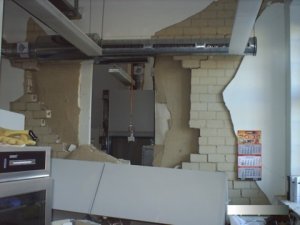 |
